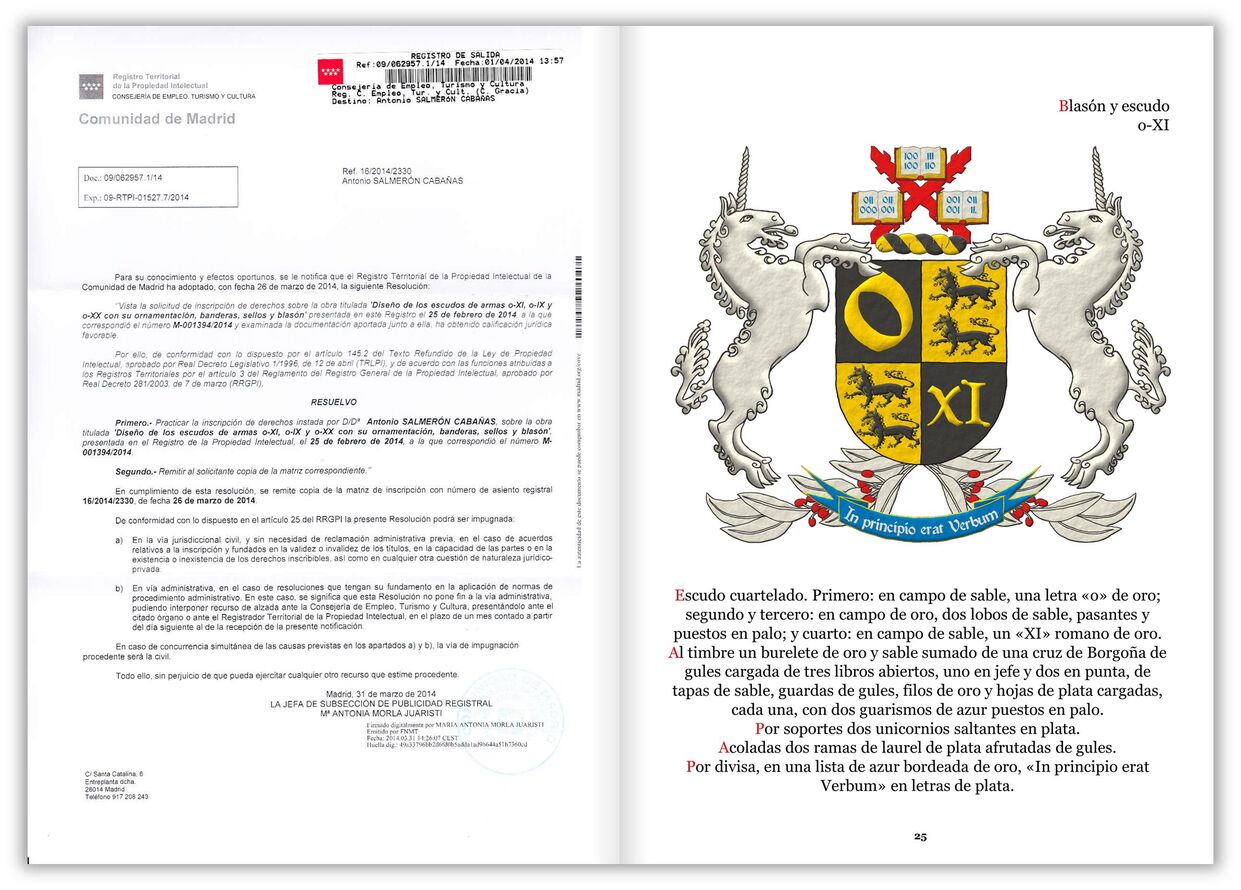
![Ver [Cuena Bartolomé, J.; 1968] en referencias bibliográficas. Libro abierto, hojas de plata, filo de oro, guardas de gules, tapas de sable.](../css/Libro.Bibliografia.png)
Cuena Bartolomé, J.; 1968
José Cuena Bartolomé, Doctor of Civil Engineering (Roads, Canals and Harbours) of the Computing Office of the Center for Studies and Experimentation of Public Works, «The ordered trial of solutions in hydraulic systems by means of mathematical simulation models on an electronic computer» Journal of «Obras Públicas» del College of Roads, Canals and Harbours, 115, volume I, number 3038, pages 413-430, ISSN 0034-8619, ISSN electronic 1695-4408, Legal Deposit M-156-1958, Madrid, June 1968.
Bibliographical reference of century XX.
Classification: Magazine and Castilian language.
Author: José Cuena Bartolomé.
Bibliographical reference mentioned in the following article:


![Ver [Registro Internacional de Armas Gentilicias] en instituciones citadas. Fortaleza de oro y mazonada de sable.](../css/Fortaleza.Institucion.png)
Registro Internacional de Armas Gentilicias
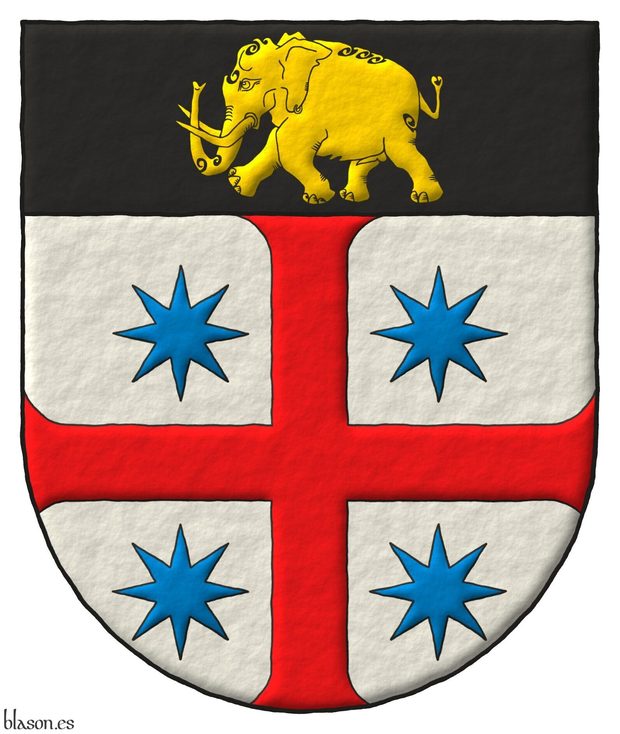
RIAG
Argent, a cross patty Gules, cantoned of four mullets of eight points Azure; on a chief Sable, an elephant passant Or.
The Registro Internacional de Armas Gentilicias, is also known as RIAG, and riag.com.es is it domain.
It is a private register of coat of arms founded in 2006 in Seville, Spain by the herald Ignacio Koblischek Zaragoza.
Categories: Institution, Socioeconomic, Semi-circular, Illuminated, Outlined in sable, Outlined in the field tincture, Freehand, Argent, Diminished cross, Patty, Gules, Cantoned, Mullet, Eight, Azure, Chief, Sable, Elephant, Passant and Or.


Burgos, University of
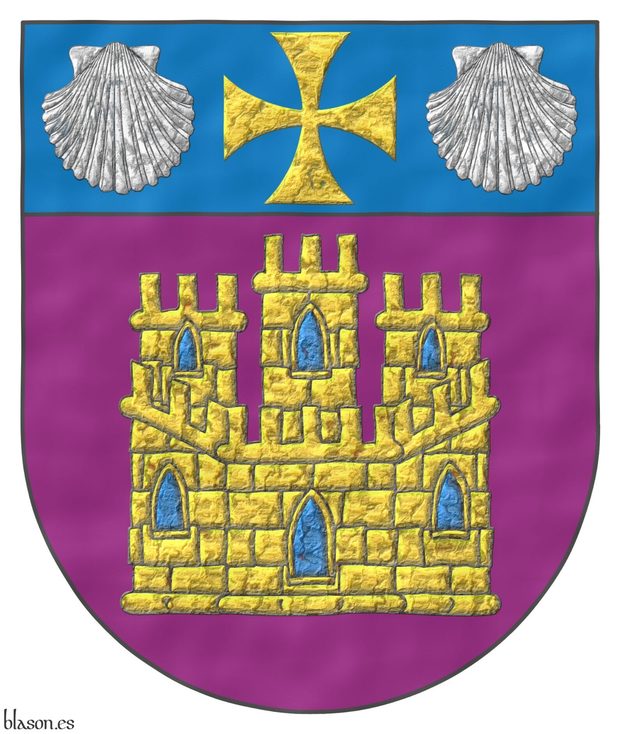
Purpure, a castle triple-towered Or, port and windows Azure, masoned Sable; on a chief Azure, a cross patty Or, between two escallops Argent.
Escudo de púrpura, un castillo de oro, aclarado de azur, mazonado de sable; un jefe de azur, cargado de una cruz patada de oro acompañada de dos veneras de plata.
Coat of arms interpreted with: a semicircular (round) base; the field and the chief watercolored in the flat tinctures Purpure and Azure; and the charges illuminated, outlined in Sable, with a very hammered metal finish.
Although it is a university of recent creation, in 1994, its best-known campus is the so-called Hospital del Rey, located on the edge of the Way of St. James and originally intended to care for pilgrims and founded, in 1195, by Alfonso VIII of Castile and Eleanor Plantagenet. The effigies of both monarchs decorate the main gate of the Hospital, called the Gate of the Pilgrims, which is, in turn, the symbol of the University of Burgos.
Regarding the escallop (venera), [Valero de Bernabé, L.; Márquez de la Plata, V. M.; 2003; page 197] notes that among the wide variety of shells, it is the scallop or pilgrim’s shell that is most used in heraldry and in blazons it is named «venera», and that it is drawn with its concave side against the field and its convex side visible, with its ribs vertical and its ears (auricles) toward the chief of the shield, and that when the concave side is shown one must specify it in the blazon as «alzada», and when the ears are in a different tincture it is said «orejada», for example, «an escallop Or, its ears Gules».
Blazon keywords: Purpure, Or, Azure, Sable, Argent, Castle, Chief, Cross, Cross patty, Cross couped and Escallop.
Style keywords: Semi-circular, Illuminated, Outlined in sable, Watercolor and Hard metal.
Classification: Interpreted, Socioeconomic and Education.
Bearer: Burgos, University of.


UBU

Purpure, a castle triple-towered Or, port and windows Azure, masoned Sable; on a chief Azure, a cross patty Or, between two escallops Argent.
Escudo de púrpura, un castillo de oro, aclarado de azur, mazonado de sable; un jefe de azur, cargado de una cruz patada de oro acompañada de dos veneras de plata.
Coat of arms interpreted as follows: with a semicircular (round) base; the field and the chief in the flat tinctures Purpure and Azure, with a lightly-hammered metal finish; and the four charges outlined in Sable, shaded, illuminated, and with a very hammered metal finish.
I hold the University Specialist degree in Real Estate Management and Administration, awarded by the Department of Private Law of the University of Burgos. These studies are structured over three academic years and are pursued online in combination with periods of traditional classes in the summers and on-site examinations during the winters. This was my first long-term online training experience.
Blazon keywords: Purpure, Or, Azure, Sable, Argent, Castle, Chief, Cross, Cross patty, Cross couped and Escallop.
Style keywords: Semi-circular, Illuminated, Shaded, Outlined in sable, Soft metal and Hard metal.
Classification: Interpreted, Socioeconomic and Education.
Bearer: Burgos, University of.


![Ver [Royal Association of Hidalgos of Spain] en instituciones citadas. Fortaleza de oro y mazonada de sable.](../css/Fortaleza.Institucion.png)
Royal Association of Hidalgos of Spain
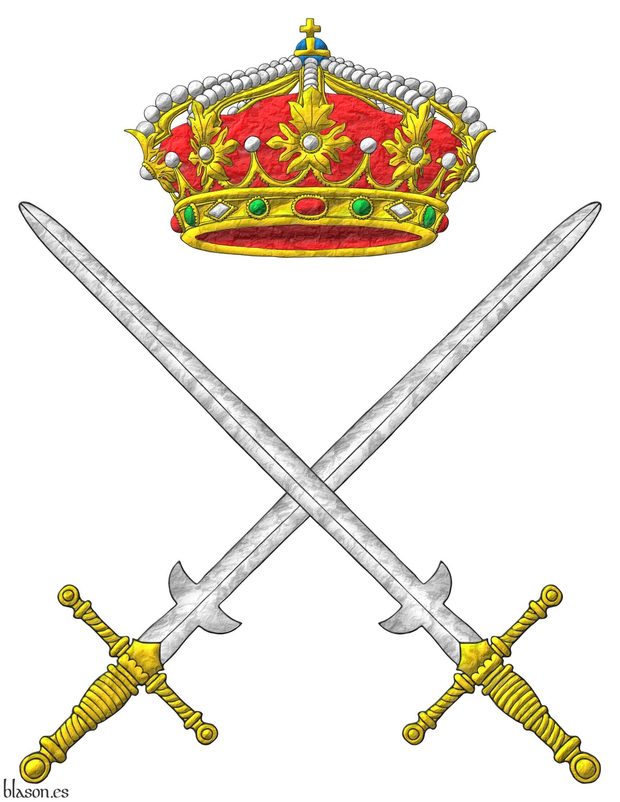
The Royal Association of Hidalgos of Spain was founded under the name «Asociación de Hidalgos, Infanzones y Noblezas a Fuero de España» by Vicente and Francisco de Cadenas y Vicent, the Marquises of Siete Iglesias and of Zayas, and also by Valentín Dávila Jalón, Marquis of Dávila.
This association brings together nobles of Spanish lineages with the aim of maintaining and promoting the traditional values of the hidalguía and is inspired by the principles of Christian humanism. It fulfills its duty to provide services to Spain, its institutions and its citizens, with loyalty to the Crown and commitment to Spanish culture and history.
Its magazine Hidalgos, also known as «La Gacetilla de Hidalgos de España», or simply «La Gacetilla», as this was its name until the end of 2010, precisely until its issue 524 of October, November and December 2010. This magazine is an excellent source of knowledge and information, and some of its articles are cited throughout Blason.es, for example, those by [Valero de Bernabé, L.; 2009b], [Valero de Bernabé, L.; 2010] and [Valero de Bernabé, L.; 2012b].
In saltire arrangements, I prefer to place the element in bend over the element in bend sinister, since the bend takes precedence over the bend sinister. Therefore, in my interpretation of this coat of arms and unlike other interpretations, the two-handed sword placed in bend is drawn above the one placed in bend sinister.
Categories: Institution, Interpreted, Socioeconomic, Illuminated, Outlined in sable, Metal beaten, Emblem, Two-handed sword, Argent, Hilted, Or, In saltire, Crest, Closed royal crown and Crown.


Royal Association of Hidalgos of Spain, emblem

Emblem, two two-handed swords in saltire Argent, hilted Or. Crest: A royal crown Or.
Emblema, dos mandobles en sotuer de plata, guarnecidos de oro. Timbrado de una corona real.
Emblem interpretation with: the two-handed swords placed along the diagonals of an imaginary rectangle, with a 5x6 proportion, like a shield, that is, with angles of 50.2°, between the axis of the two-handed swords and the imaginary base of the emblem, unlike the original emblem where the two-handed swords are on the diagonals of a square, therefore with angles of 45°; the two-handed swords and the closed royal crown are outlined in Sable, illuminated and the whole with a raised-stroke execution.
This emblem of the Royal Association of Hidalgos of Spain has 2 two-handed swords that, unlike usual swords, due to their great length and weight, their fencing must be two-handed, hence their name.
The Spanish word «mandoble» comes from «mano doble», meaning «double hand», and refers to a sword wielded with both hands, the equivalent of the English «two-handed sword».
It is known that they are two-handed swords because the 2 that appear in the emblem have a crescent or crossguard in their iron. This crescent is called in Castilian «falsaguarda» and also «ganchos de parada» and its functionality is to protect from the slashes that the opponent could give close to the blade of the two-handed sword.
Blazon keywords: Two-handed sword, Argent, Hilted, Or, In saltire, Crest, Closed royal crown and Crown.
Style keywords: Illuminated, Outlined in sable and Freehand.
Classification: Interpreted, Socioeconomic and Emblem.
Bearer: Royal Association of Hidalgos of Spain.


![Ver [Salmerón Cabañas, A.; 2014a] en referencias bibliográficas. Libro abierto, hojas de plata, filo de oro, guardas de gules, tapas de sable.](../css/Libro.Bibliografia.png)
Salmerón Cabañas, A.; 2014a
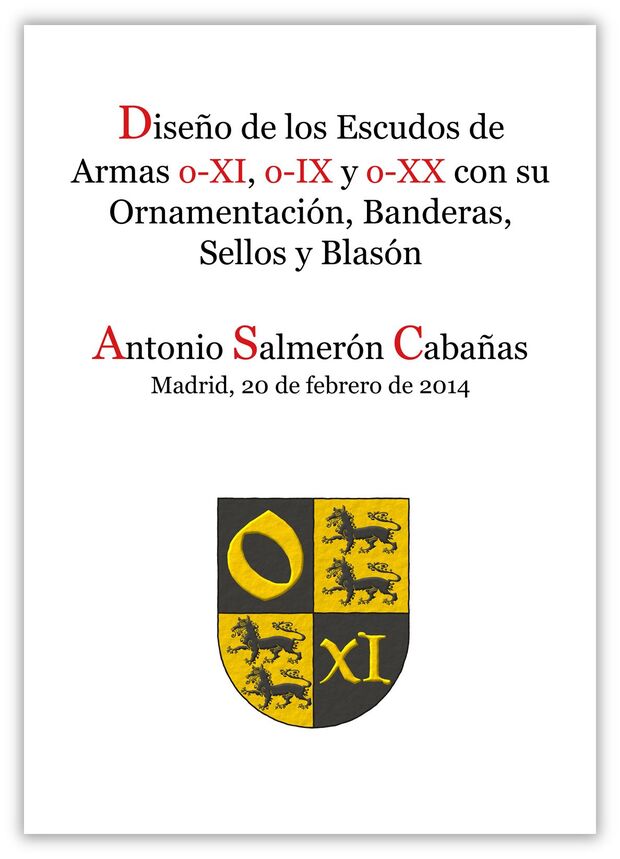
Antonio Salmerón Cabañas, «Design of the coats of arms o-XI, o-IX, o-XX with their crest, supporters, flags, seals and blazons», paintings registered in the Intellectual Property Registry of Madrid, 28 pages with 47 illustrations, of coats of arms and other heraldic objects, request code M-1394-14, registration number 16/2014/2330, Madrid, 25th of February of 2014.
In this registration are the illustrations from my book [Salmerón Cabañas, A.; 2014b] titled «The Book of the Coat of Arms of Wolves Sable and Unicorns Argent».
Bibliographical reference of century XXI.
Author: Salmerón Cabañas, Antonio.
The following article cites this bibliographic reference:


![Ver [Valero de Bernabé, L.; 2014] en referencias bibliográficas. Libro abierto, hojas de plata, filo de oro, guardas de gules, tapas de sable.](../css/Libro.Bibliografia.png)
Valero de Bernabé, L.; 2014
Luis Valero de Bernabé y Martín de Eugenio, «El Bestiario Heráldico Balear», 48 pages, estimated publication date 16th of September of 2014.
It consists of an introduction and a series of chapters that deal with terrestrial animals, native wild animals, exotic animals, domestic animals, aerial animals, aquatic animals, and fantastic animals.
I only have the work in a digital PDF format and I do not know if it has been published in any other medium or format.
Bibliographical reference of century XXI.
Author: Valero de Bernabé y Martín de Eugenio, Luis.
Internal resources: ValeroBernabeL2014.BestiarioHeraldicoBalear.pdf.

Continue with: Valero de Bernabé, L.; Márquez de la Plata, V. M.; 2003.
-
Language
-
Categories of heraldry
-
Divisions of the field
- Without divisions
- Party per pale
- Party per fess
- Party per bend
- Party per bend sinister
- Tierce
- Tierce sinister
- Tierced per pale
- Tierced per fess
- Tierced per bend
- Tierced pallwise inverted
- Quarterly
- Quarterly per saltire
- Gyronny
- Party per fess, the chief per pale
- Party per pale, the sinister per fess
- Party per fess, the base per pale
- Party per pale, the dexter per fess
- Chapé
- Chaussé
- Embrassé
- Contre-embrassé
- Party per chevron
- Enté
- Enté en point
- Flanched
-
Metals
-
Colours
-
Furs
-
Other tinctures
-
Ordinaries and sub-ordinaries
-
Diminutives of the ordinaries
-
Other charges
-
Inanimate charges from Nature
Atom, Crescent, Diamond, Emerald, Estoile, Increscent, Lightning flash, Moon, Mount, Mullet, Mullet of four points, Orbital, Plough of Ursa Major, Rainbow, Ray of the sun, River, Sea, Snowflake, Sun, Sun in splendour, Trimount and Water.
-
Vegetal charges from Nature
Acorn, Apple, Apple tree, Ash, Bluebonnet, Camellia, Chrysanthemum, Cinquefoil, Cornflower, Dogwood flower, Double rose, Elm, Fleur de lis, Flower, Holm oak, Hop cone, Kapok tree, Laurel, Lily, Linden, Lotus flower, Madonna lily, Oak, Olive tree, Palm tree, Pomegranate, Poplar leaf, Rose, Shamrock, Sunflower, Thistle, Tree, Tulip, Vine and Wheat.
-
Animal charges from Nature
Badger, Bald eagle, Barbel, Barn owl, Bear, Beaver, Beetle, Bighorn sheep, Blackbird, Boar, Brach hound, Bull, Doe, Dog, Dolphin, Dove, Eagle, Elephant, Falcon, Fish, Flame, Fly, Fox, Frog, Goat, Goldfinch, Goose, Heron, Horse, Hummingbird, Jaguar, Lark, Leopard, Lion, Lion passant, Lion rampant guardant, Lioness, Lynx, Male figure, Martlet, Merino ram, Owl, Panther, Parrot, Peacock, Pelican, Pelican in her piety, Puffin, Quetzal, Raven, Roe deer, Rooster, Savage, Seagull, Serpent, She-wolf, Stag, Starling, Tyger, Vulture, Warren hound and Wolf.
-
Parts of natural charges
Arm, Beak, Branch, Caboshed, Chest, Claw, Covert, Dorsal fin, Eagle claw, Ermine spot, Escallop, Feather, Foot (palmiped), Foreleg, Forepaw, Hand, Head, Heart, Hoof, Leaf, Neck, Ostrich feather, Palm frond, Paw, Roe deers' attires, Shoulder, Sprig, Stags' attires, Stem, Swallow-tail, Tail, Tail addorsed, Tail fin, Talon, Tooth, Trunk, Trunk (elephant), Two hands clasped, Two wings in vol, Udder, Wheat spike, Wing and Wrist.
-
Artificial charges
Ace of spades, Anchor, Anvil, Arch, Arm vambraced, Armillary sphere, Arrow, Axe, Bell, Bell tower, Beret, Bonfire, Book, Bookmark, Bow, Bridge, Broken, Buckle, Cannon, Cannon dismounted, Cannon port, Carbuncle, Castle, Celtic Trinity knot, Chain, Chess rooks, Church, Clarion, Clay pot, Closed book, Club, Comb, Compass rose, Conductor's baton, Cord, Covered cup, Crozier, Crucible, Cuffed, Cup, Cyclamor, Dagger, Double vajra, Drum, Ecclesiastical cap, Fanon, Federschwert, Fleam, Four crescents joined millsailwise, Galician granary, Garb, Gauntlet, Geometric solid, Grenade, Halberd, Hammer, Harp, Host, Hourglass, Key, Key ward, Knight, Knot, Lantern, Letter, Line, Loincloth, Menorah, Millrind, Millstone, Millwheel, Monstrance, Mortar, Mullet of six points pierced, Nail, Non-classic artifact, Norman ship, Number, Oar, Oil lamp, Open book, Page, Pair of scales, Parchment, Pestle, Piano, Plough share, Polish winged hussar, Portcullis, Potent, Quill, Ribbon, Rosette of acanthus leaves, Sabre, Sackbut, Sail, Scroll, Scythe, Sheaf of tobacco, Ship, Skirt, Spear, Spear's head, Star of David, Sword, Symbol, Tetrahedron, Torch, Tower, Trident, Trumpet, Turret, Two-handed sword, Wagon-wheel, Water-bouget, Wheel, Winnowing fan and With a turret.
-
Immaterial charges
Angel, Archangel, Basilisk, Dragon, Dragon's head, Garuda, Golden fleece, Griffin, Heart enflamed, Mermaid, Our Lady of Mercy, Ouroboros, Paschal lamb, Pegasus, Phoenix, Sacred Heart of Jesus, Saint George, Sea-griffin, Trinity, Triton, Unicorn, Winged hand and Wyvern.
-
External elements
-
Heraldic creations
-
References
-
Formats
-
Keywords on this page
Watercolor, Azure, Bibliography, Burgos, University of, Cantoned, Castle, Crest, Crown, Closed royal crown, Cross, Cross patty, Cross couped, Outlined in sable, Outlined in the field tincture, Doctor, Education, Elephant, Emblem, In saltire, Diminished cross, Mullet, Hilted, Gules, Illuminated, Institution, Interpreted, Chief, Castilian language, Two-handed sword, Semi-circular, Metal beaten, Hard metal, Soft metal, Eight, Or, Passant, Patty, Argent, Intellectual property, Purpure, Registro Internacional de Armas Gentilicias, Magazine, Royal Association of Hidalgos of Spain, Sable, Century XX, Century XXI, Socioeconomic, Freehand and Escallop.
